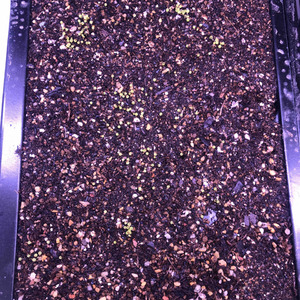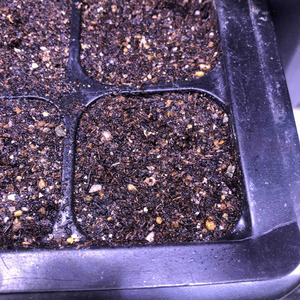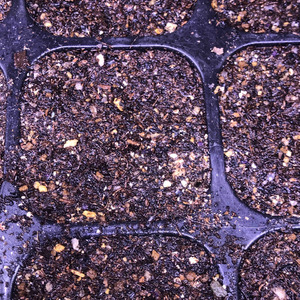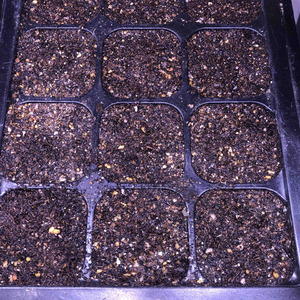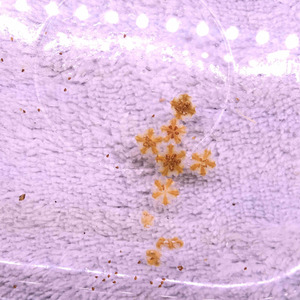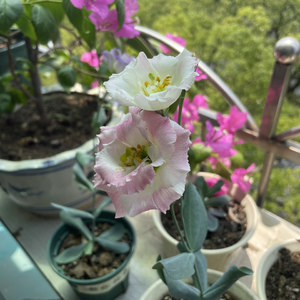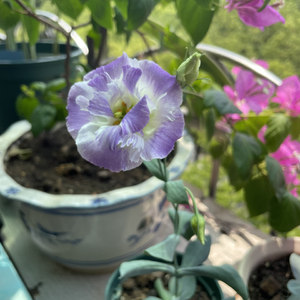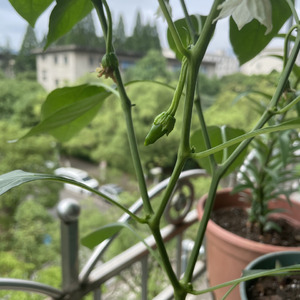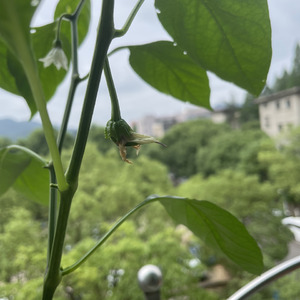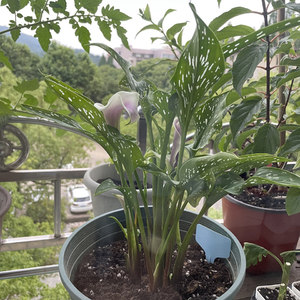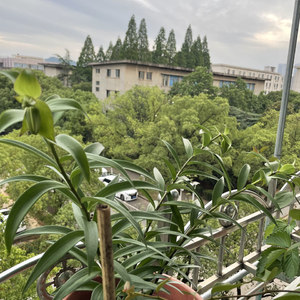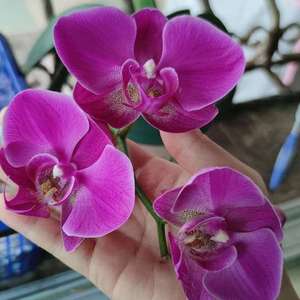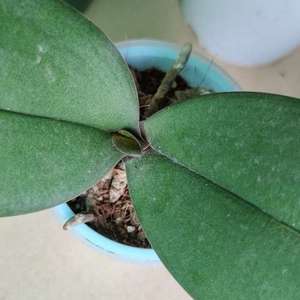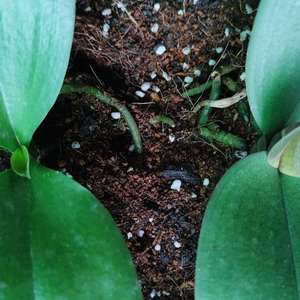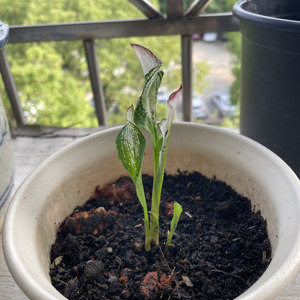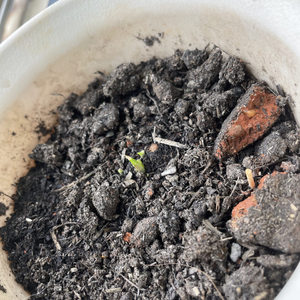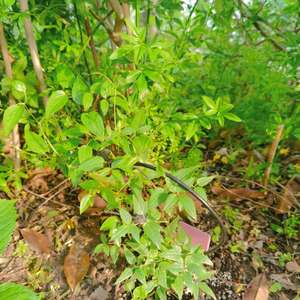成长记
嘉多宝
2022年09月21日

突然发现两年多没更新这货的情况了
一直属于不怎么管式放养,结果还分外争气,数了数,光是从土里钻出来的侧枝就有6个,现在都已经很粗很硬了,主干高处也有3个分枝,真的不要太给力!
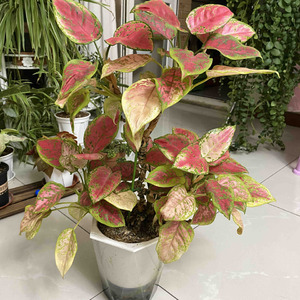
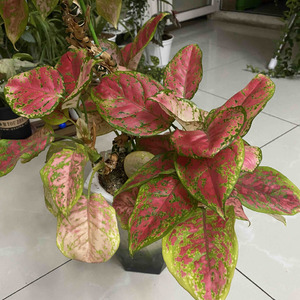
一直属于不怎么管式放养,结果还分外争气,数了数,光是从土里钻出来的侧枝就有6个,现在都已经很粗很硬了,主干高处也有3个分枝,真的不要太给力!


0
0
文章
Miss Chen
2022年06月13日

Cotton rose (Hibiscus mutabilis) is a large flowering shrub with bright green, lobed, hairy leaves that stretch roughly 3 to 6 inches long and wide. The stems can grow tall and wide enough to become tree-like. But the plant's flowers are its real show-stopping feature.
They begin blooming in the summertime, starting off as a white or light pink color. Typically within one to three days, the color changes to a magenta pink and then a dark pink to red. The blooms then last for several more days. The shrub usually will have flowers at various stages of the color-change process on it all at once, providing exceptional visual interest. Fuzzy seed pods, whose cotton-like appearance gives the plant its common name, follow the flowers.
Cotton rose shrubs have a fast growth rate and should be planted in the spring.
Common Name Cotton rose
Botanical Name Hibiscus mutabilis
Family Malvaceae
Plant Type Shrub
Mature Size 6–15 ft. tall, 6–10 ft. wide
Sun Exposure Full, partial
Soil Type Loamy, well-drained
Soil pH Neutral, alkaline
Bloom Time Summer, fall
Flower Color White, pink, red
Hardiness Zones 7–11 (USDA)
Native Area Asia
Cotton Rose Care
Cotton rose can provide lots of drama in the landscape, yet it requires minimal maintenance. It’s not overly picky about its soil as long as there’s good drainage, and it can tolerate some drought. It’s even known to be deer-resistant.
You’ll typically have to prune annually, though the shrub usually doesn’t need extensive pruning. And plan to water and fertilize during the growing season.
Light
For best growth, plant your cotton rose in a spot that gets full sun, meaning at least six hours of direct sunlight on most days. The shrub also can tolerate partial shade, though it might not flower as profusely.
Soil
This shrub can grow in most soils with good drainage. But it does best in a loamy soil that’s rich in organic matter. A neutral to slightly alkaline soil pH is ideal.
Water
While cotton rose can tolerate some drought, it’s best to maintain a moderate amount of moisture during the growing season. A good rule of thumb is to water when the top 2 inches of soil dry out. Water minimally during the winter—just enough to prevent the soil from fully drying out. Try to avoid getting the foliage wet when watering, as this can promote fungal growth.
Temperature and Humidity
This is not a cold-hardy shrub. Frost will cause it to drop its leaves in the fall and enter dormancy. Then, it can tolerate temperatures slightly below freezing over the winter, but anything colder might damage or kill the shrub. Humidity typically isn’t a factor as long as adequate soil moisture and good air circulation around the shrub are maintained.
Fertilizer
Fertilizer isn't essential unless you have poor soil, but it can help to speed growth. Use a balanced fertilizer during the growing season, following label instructions.
Types of Cotton Rose
There are several types of cotton rose, including:
'Cotton Rose Nagoya': This cultivar features white flowers.
'Plenus': This cultivar is known for its double blooms.
'Rubra': Red flowers are the trademark of this cultivar.
Pruning
Prune your cotton rose in the late winter or early spring. Remove any damaged or diseased stems as they arise. Usually only a light pruning is necessary to shape growth. But if your shrub has become leggy and unsightly, you can cut it back almost to the ground. New shoots will quickly grow to fill in the space.
Propagating Cotton Rose
Cotton rose can be propagated by stem cuttings. Not only is this a cheap and easy way to get new plants, but it also allows you to put any stems that you pruned off to good use. The best time to take cuttings is in the late winter to early spring. Here’s how:
Trim off a piece of healthy stem that’s around 1 to 1.5 feet long. Cut just below a leaf node, and make your cut at a 45-degree angle.
Dip the cut end in rooting hormone.
Plant the cutting in a moist soilless potting mix. Use a 1-gallon container with drainage holes.
Place the container in a bright, south-facing window or in a sheltered area that gets partial sun outside if you live in a warmer climate.
Keep the soil lightly moist but never waterlogged, and roots should form in roughly four to six weeks.
How to Grow Cotton Rose From Seed
Direct sow cotton rose seeds in the spring; they germinate best when the temperatures are between roughly 55 and 65 degrees Fahrenheit. Plant them about 1/4 inch deep, and keep the soil moist but not waterlogged. You should see germination within a week or two, and plants can even flower in their first year if they're started early enough.
Potting and Repotting Cotton Rose
It’s possible to grow cotton rose in a pot, but this likely will stunt the shrub’s growth and diminish its blooms. Also, note that container plants generally need more frequent watering than those grown in the ground.
Use a quality all-purpose potting mix with good drainage. And select a container that allows for at least a few inches of extra space on all sides of the plant’s root ball. The container also should have drainage holes. Unglazed clay is a good material to allow excess soil moisture to evaporate through its walls. But you might want to consider using a grow bag because it will be lighter to move.
When you see roots coming out of the drainage holes and popping up from the soil line, it’s time to repot. It’s best to do this in the spring. Choose a container size up, and add fresh soil around the root ball.
Overwintering
In the colder parts of cotton rose's growing zones, the stems often naturally die back over the winter. But the shrub still should produce fresh growth in the spring. Plan to prune off the stems that have died back in the late winter to early spring. If you do it earlier as part of your garden's overwintering maintenance, this can damage the shrub.
If you’re growing your cotton rose in a container and live in the cooler parts of its growing zones, bring it into an unheated garage or shed over the winter. This will help to prevent the container soil from getting too cold and damaging the plant's roots.
Common Pests & Plant Diseases
Cotton rose is susceptible to some common garden pests, including aphids, mealybugs, whiteflies, spider mites, and scale. Infestations often can be treated with insecticidal soaps or even a strong spray of water.
Common diseases include leaf spot, southern stem blight, and powdery mildew. Remove any stems with signs of fungal growth. Also, aim to prevent fungal diseases by watering only at the base of the plant and maintaining good air flow around it.
How to Get Cotton Rose to Bloom
Cotton rose flowers are a saucer shape with four to five petals each. They stretch around 3 to 6 inches across. Blooming typically begins in the late summer and stretches into fall. The flowers won't provide fragrance for your garden, but they will attract many beneficial pollinators.
It's not essential to deadhead, or remove the spent blooms, but it can help to promote further blooming. However, this plant will typically bloom profusely on its own as well. Just make sure it has sufficient sunlight, moisture, and organic matter in the soil to support flowering.
Common Problems With Cotton Rose
When grown in the conditions it likes, cotton rose isn’t prone to serious problems. However, an inadequate environment can lead to some common issues.
Leaves Turning Yellow
Yellowing leaves can often be a sign of overwatering or underwatering. Make sure the soil is never waterlogged. But on the flip side, plan to water a little extra in hot weather.
Plant Leaves Falling Off
In the warmest parts of its growing zones, this shrub often holds onto its leaves year-round. But during the winter months in its cooler zones, it will naturally drop some or all of its leaves. This isn’t cause for concern, as it will regrow come spring. However, leaf drop during the growing season can be a sign of inadequate watering or disease.
FAQ
What's the difference between cotton roses and roses?
While they share a common name, cotton roses are actually members of the Hibiscus genus while roses are of the Rosa genus. However, both plants’ showy blooms do somewhat resemble each other.
Where should I place cotton rose outside my house?
The cotton rose can make for a dramatic specimen planting, providing a showy floral display toward the end of the growing season when many other plants have already wrapped up their blooming period. It also can be grown as a shrub border.
Can cotton rose be grown indoors?
It is not ideal to try to grow cotton rose shrubs indoors. They require direct sunlight to grow and bloom at their best. And they generally become too large to be a houseplant.
They begin blooming in the summertime, starting off as a white or light pink color. Typically within one to three days, the color changes to a magenta pink and then a dark pink to red. The blooms then last for several more days. The shrub usually will have flowers at various stages of the color-change process on it all at once, providing exceptional visual interest. Fuzzy seed pods, whose cotton-like appearance gives the plant its common name, follow the flowers.
Cotton rose shrubs have a fast growth rate and should be planted in the spring.
Common Name Cotton rose
Botanical Name Hibiscus mutabilis
Family Malvaceae
Plant Type Shrub
Mature Size 6–15 ft. tall, 6–10 ft. wide
Sun Exposure Full, partial
Soil Type Loamy, well-drained
Soil pH Neutral, alkaline
Bloom Time Summer, fall
Flower Color White, pink, red
Hardiness Zones 7–11 (USDA)
Native Area Asia
Cotton Rose Care
Cotton rose can provide lots of drama in the landscape, yet it requires minimal maintenance. It’s not overly picky about its soil as long as there’s good drainage, and it can tolerate some drought. It’s even known to be deer-resistant.
You’ll typically have to prune annually, though the shrub usually doesn’t need extensive pruning. And plan to water and fertilize during the growing season.
Light
For best growth, plant your cotton rose in a spot that gets full sun, meaning at least six hours of direct sunlight on most days. The shrub also can tolerate partial shade, though it might not flower as profusely.
Soil
This shrub can grow in most soils with good drainage. But it does best in a loamy soil that’s rich in organic matter. A neutral to slightly alkaline soil pH is ideal.
Water
While cotton rose can tolerate some drought, it’s best to maintain a moderate amount of moisture during the growing season. A good rule of thumb is to water when the top 2 inches of soil dry out. Water minimally during the winter—just enough to prevent the soil from fully drying out. Try to avoid getting the foliage wet when watering, as this can promote fungal growth.
Temperature and Humidity
This is not a cold-hardy shrub. Frost will cause it to drop its leaves in the fall and enter dormancy. Then, it can tolerate temperatures slightly below freezing over the winter, but anything colder might damage or kill the shrub. Humidity typically isn’t a factor as long as adequate soil moisture and good air circulation around the shrub are maintained.
Fertilizer
Fertilizer isn't essential unless you have poor soil, but it can help to speed growth. Use a balanced fertilizer during the growing season, following label instructions.
Types of Cotton Rose
There are several types of cotton rose, including:
'Cotton Rose Nagoya': This cultivar features white flowers.
'Plenus': This cultivar is known for its double blooms.
'Rubra': Red flowers are the trademark of this cultivar.
Pruning
Prune your cotton rose in the late winter or early spring. Remove any damaged or diseased stems as they arise. Usually only a light pruning is necessary to shape growth. But if your shrub has become leggy and unsightly, you can cut it back almost to the ground. New shoots will quickly grow to fill in the space.
Propagating Cotton Rose
Cotton rose can be propagated by stem cuttings. Not only is this a cheap and easy way to get new plants, but it also allows you to put any stems that you pruned off to good use. The best time to take cuttings is in the late winter to early spring. Here’s how:
Trim off a piece of healthy stem that’s around 1 to 1.5 feet long. Cut just below a leaf node, and make your cut at a 45-degree angle.
Dip the cut end in rooting hormone.
Plant the cutting in a moist soilless potting mix. Use a 1-gallon container with drainage holes.
Place the container in a bright, south-facing window or in a sheltered area that gets partial sun outside if you live in a warmer climate.
Keep the soil lightly moist but never waterlogged, and roots should form in roughly four to six weeks.
How to Grow Cotton Rose From Seed
Direct sow cotton rose seeds in the spring; they germinate best when the temperatures are between roughly 55 and 65 degrees Fahrenheit. Plant them about 1/4 inch deep, and keep the soil moist but not waterlogged. You should see germination within a week or two, and plants can even flower in their first year if they're started early enough.
Potting and Repotting Cotton Rose
It’s possible to grow cotton rose in a pot, but this likely will stunt the shrub’s growth and diminish its blooms. Also, note that container plants generally need more frequent watering than those grown in the ground.
Use a quality all-purpose potting mix with good drainage. And select a container that allows for at least a few inches of extra space on all sides of the plant’s root ball. The container also should have drainage holes. Unglazed clay is a good material to allow excess soil moisture to evaporate through its walls. But you might want to consider using a grow bag because it will be lighter to move.
When you see roots coming out of the drainage holes and popping up from the soil line, it’s time to repot. It’s best to do this in the spring. Choose a container size up, and add fresh soil around the root ball.
Overwintering
In the colder parts of cotton rose's growing zones, the stems often naturally die back over the winter. But the shrub still should produce fresh growth in the spring. Plan to prune off the stems that have died back in the late winter to early spring. If you do it earlier as part of your garden's overwintering maintenance, this can damage the shrub.
If you’re growing your cotton rose in a container and live in the cooler parts of its growing zones, bring it into an unheated garage or shed over the winter. This will help to prevent the container soil from getting too cold and damaging the plant's roots.
Common Pests & Plant Diseases
Cotton rose is susceptible to some common garden pests, including aphids, mealybugs, whiteflies, spider mites, and scale. Infestations often can be treated with insecticidal soaps or even a strong spray of water.
Common diseases include leaf spot, southern stem blight, and powdery mildew. Remove any stems with signs of fungal growth. Also, aim to prevent fungal diseases by watering only at the base of the plant and maintaining good air flow around it.
How to Get Cotton Rose to Bloom
Cotton rose flowers are a saucer shape with four to five petals each. They stretch around 3 to 6 inches across. Blooming typically begins in the late summer and stretches into fall. The flowers won't provide fragrance for your garden, but they will attract many beneficial pollinators.
It's not essential to deadhead, or remove the spent blooms, but it can help to promote further blooming. However, this plant will typically bloom profusely on its own as well. Just make sure it has sufficient sunlight, moisture, and organic matter in the soil to support flowering.
Common Problems With Cotton Rose
When grown in the conditions it likes, cotton rose isn’t prone to serious problems. However, an inadequate environment can lead to some common issues.
Leaves Turning Yellow
Yellowing leaves can often be a sign of overwatering or underwatering. Make sure the soil is never waterlogged. But on the flip side, plan to water a little extra in hot weather.
Plant Leaves Falling Off
In the warmest parts of its growing zones, this shrub often holds onto its leaves year-round. But during the winter months in its cooler zones, it will naturally drop some or all of its leaves. This isn’t cause for concern, as it will regrow come spring. However, leaf drop during the growing season can be a sign of inadequate watering or disease.
FAQ
What's the difference between cotton roses and roses?
While they share a common name, cotton roses are actually members of the Hibiscus genus while roses are of the Rosa genus. However, both plants’ showy blooms do somewhat resemble each other.
Where should I place cotton rose outside my house?
The cotton rose can make for a dramatic specimen planting, providing a showy floral display toward the end of the growing season when many other plants have already wrapped up their blooming period. It also can be grown as a shrub border.
Can cotton rose be grown indoors?
It is not ideal to try to grow cotton rose shrubs indoors. They require direct sunlight to grow and bloom at their best. And they generally become too large to be a houseplant.
0
0
成长记
嘉多宝
2022年04月25日

修剪之后原盆状态一直不太好,近期慢慢稳定了,也是向阳一边倒了(图1)……剪下来的一堆水培的还不错(图2),另外土培的只剩一棵光杆司令了,因为不怎么见光,颜色也不好了……(图3)
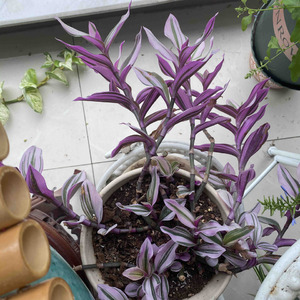

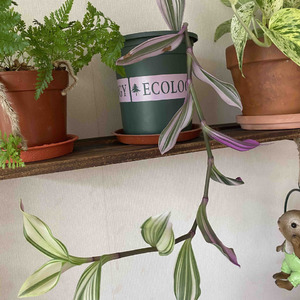



0
0
成长记
绿萝
2022年04月20日

今天狠心打了顶,问了老板,在图4位置打顶,好怕不长了,留多了一些图2,剩下的舍不得丢,插在太阳花的盆子里面了图3,不知道能不能长,不打顶是不是也可?(>人<;)


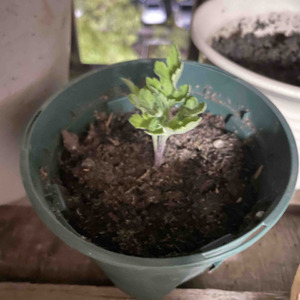
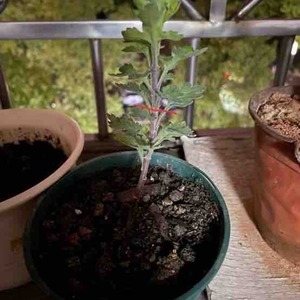




0
0
文章
Miss Chen
2022年03月24日

If you are looking for a plant that boasts dramatic, vibrant flowers, you may want to consider tropical hibiscus. The trumpet-shaped blooms are typically 3 to 8 inches in diameter with dramatic protruding stamens.
Native to Asia, tropical hibiscus plants produce flowers constantly, but each blossom only lasts one day. The shrub is fast-growing and can add up to 24 inches per year, eventually reaching heights of up 15 feet when growing under the ideal conditions. In colder climates, they are often planted as container specimens that are either replanted annually or brought indoors during the cold months. Start new plants in spring, whether in the ground or containers.
Common Name Tropical hibiscus, Chinese hibiscus, China rose
Botanical Name Hibiscus rosa-sinensis
Family Malvaceae
Plant Type Evergreen shrub
Mature Size 4–10 ft. tall, 5–8 ft. wide
Sun Exposure Full sun, partial shade
Sun Type Moist but well-drained
Soil pH Neutral to acidic
Bloom Time Summer to fall in containers; year-round outdoors in tropical climates
Flower Color White, red, pink, orange, yellow, peach, and purple
Hardiness Zones 9–11 (USDA)
Native Area Asia
Tropical Hibiscus Care
No matter where you live, there's a way for to you enjoy a hibiscus plant, at least for part of the year. In warmer climates, tropical hibiscus plants are grown as perennial garden plants and used as shrubs for hedges and screens. Meanwhile, in colder climates, they're often planted in large containers as patio or deck specimens. With dozens of colors of flowers to choose from, the plants will reward your garden and home with days and days of vibrant blooms reminiscent of a vacation in the tropics.
Light
While you may assume that a tropical plant like the hibiscus loves the sun, it's more nuanced than that. In northern climates, your hibiscus plants will probably be happiest in full sun. However, if you live somewhere that's more hot and dry, you're better off putting your plant in a location that gets partial shade.
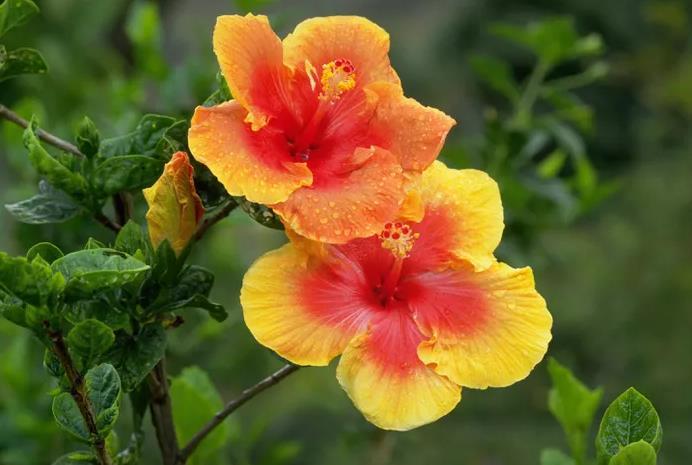
If your outdoor plant is consistently producing hibiscus flowers, it is happy, so keep doing what you're doing. If your plant is not producing buds and flowers, try moving it into an area that has more sunlight.
Soil
If you're growing your hibiscus plant in a container, use a well-drained potting mix as the soil, preferably one formulated for tropical plants. Outdoors, your soil should have lots of organic matter. The soil in both grow locations should be well-draining, to help avoid the risk of root rot.
Water
Tropical hibiscus is a thirsty plant and will thrive and produce blossoms only if it is given enough water. Depending on the heat, wind, and humidity in your environment, your plant may need to be watered daily, or even twice a day in extremely dry conditions. Typically, tropical hibiscus plants thrive best with 1 to 2 inches of water per week.
Temperature and Humidity
The tropical hibiscus plant prefers average temperatures between 55 and 70 degrees Fahrenheit. The plant can be killed by even a few nights below 50 degrees Fahrenheit, so plan to move it inside if cold weather is in the forecast.
Fertilizer
When you buy a potted hibiscus, it likely has a slow-release fertilizer mixed into the soil, so it will not require additional feeding in the first few months. After that, regular feeding with a diluted fish emulsion fertilizer will keep it blooming vigorously.
Types of Tropical Hibiscus
Hibiscus rosa-sinensis 'Bonjour': This varietal constantly blooms with a mixture of red and pink flowers. It can grow 4 to 6 feet high.
Hibiscus sinensis 'Magic Moment': This plant varietal boasts 10-inch flowers in hues of peach, orange, pink, and light purple, on plants growing up to 8 feet tall.
Hibiscus rosa-sinensis 'Cajun Cocktail': This unique varietal has lovely variegated blooms that are around 6 inches wide, with no two blooms exactly alike.
Pruning
The best time for pruning tropical hibiscus is in the fall for both garden and container plants. Pruning will help keep your tropical hibiscus flowering as buds form on the new growth that has been stimulated by pruning, and removing some branches can let in some much-needed light. Give any hibiscus plants that are potted in containers a hard pruning before bringing them indoors for the winter season.
Propagating Tropical Hibiscus
Propagating tropical hibiscus using cuttings can give you the exact same plant as the parent. Propagate your tropical hibiscus from soft-stem cuttings taken in late spring or early summer after the plant has begun active growth for the season. Here's how to propagate this plant using cuttings:
Choose a stem with a greenish cast that's 4 to 6 inches long. Use a sterile, sharp cutting tool to cut the stem. Remove all but the top set of leaves from the stem.
Trim the bottom of the stem just below the bottom leaf node and dip the end in a rooting hormone.
Put the cutting in a pot of well-draining soil that's half potting soil and half perlite.
Moisten the soil and push a hole into the dirt in which you place the cutting.
Put a clear plastic bag over the plant, but make sure it does not touch the leaves. Bagging the cutting preserves moisture and retains heat while it establishes roots.
Keep the cuttings out of direct sunlight and in partial shade until they are actively growing, at which time you can repot them in a larger container.
Potting and Repotting Tropical Hibiscus
You will likely need to repot your plant every one to two years. Regular repotting helps ensure that the soil provides sufficient nutrition for the plant.
For consistent flower production in container plantings, avoid very deep containers, which can cause the plant to spend its energy on root development at the expense of producing flowers. The ideal pot shape is quite wide but relatively shallow. The best pot will be an unglazed clay material and have several draining holes (not just one). Unglazed clay pots are porous and let water and air easily flow through the plant.
Overwintering
If you live in a northern climate, it is possible to overwinter hibiscus indoors, as long as you can provide two to three hours of direct sunlight daily. Your plant will also need less water in the winter, but dry indoor heat can be hard on tropical plants, so you will need frequent shallow waterings, as well as daily misting (if the air is dry).
If you see any buds form on the plant, remove them—you don't want your hibiscus to waste any energy by flowering in the winter. In the spring, cut the plant back and put it outside once the nighttime temperatures are consistently above 50 degrees Fahrenheit.
Common Pests & Plant Diseases
Tropical hibiscus is generally free of pests and diseases, but you may encounter spider mites and aphids, especially if you bring the plant indoors.1 You should also try to remove all insects currently residing on the plant using neem oil, a liquid detergent, or by spraying the plant forcefully with water.
Hibiscus plants can also develop bacterial diseases due to transmission from insects, rain, and fog—symptoms of such can include leaf wilt, dwarfing, stem rot, and distortion of leaves.2
Common Problems With Tropical Hibiscus
There will be telltale signs that your tropical hibiscus plant may not be very happy. Here are a two common issues to watch for.
Dropping Leaves
If your plant has dropping leaves, appears stressed, or hasn't been growing well, there are three main reasons:
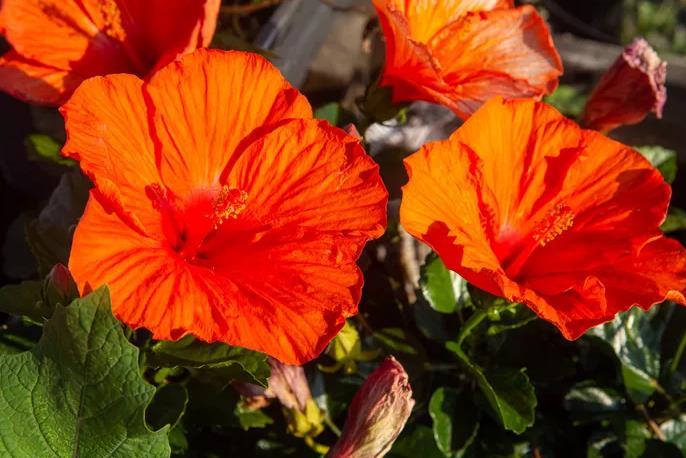
Your plant needs to be repotted.
It's overheated from living in prolonged heat that's over 85 degrees Fahrenheit.
It's being underwatered.
Yellowing Leaves
If you're seeing yellowing leaves at the top of the plant, chances are it's not getting enough water. Likewise, if your hibiscus has yellowing leaves in the middle or toward the bottom of the plant, it's probably drowning in too much water.
FAQ
Are tropical hibiscus plants easy to care for?
Tropical hibiscus plants are relatively easy to care for as long as they get enough light and water.
Why do tropical hibiscus blooms only last a day?
It takes a lot of energy for a plant to create a beautiful hibiscus bloom. However, once the bloom fades, a new one immediately takes its place. Cooler weather may yield slightly longer blooms and newer hybrids have blooms that can last three days.
How long will tropical hibiscus live?
Many traditional varieties of tropical hibiscus can live for over 50 years, but newer hybrids have a lifespan of up to 10 years.
Native to Asia, tropical hibiscus plants produce flowers constantly, but each blossom only lasts one day. The shrub is fast-growing and can add up to 24 inches per year, eventually reaching heights of up 15 feet when growing under the ideal conditions. In colder climates, they are often planted as container specimens that are either replanted annually or brought indoors during the cold months. Start new plants in spring, whether in the ground or containers.
Common Name Tropical hibiscus, Chinese hibiscus, China rose
Botanical Name Hibiscus rosa-sinensis
Family Malvaceae
Plant Type Evergreen shrub
Mature Size 4–10 ft. tall, 5–8 ft. wide
Sun Exposure Full sun, partial shade
Sun Type Moist but well-drained
Soil pH Neutral to acidic
Bloom Time Summer to fall in containers; year-round outdoors in tropical climates
Flower Color White, red, pink, orange, yellow, peach, and purple
Hardiness Zones 9–11 (USDA)
Native Area Asia
Tropical Hibiscus Care
No matter where you live, there's a way for to you enjoy a hibiscus plant, at least for part of the year. In warmer climates, tropical hibiscus plants are grown as perennial garden plants and used as shrubs for hedges and screens. Meanwhile, in colder climates, they're often planted in large containers as patio or deck specimens. With dozens of colors of flowers to choose from, the plants will reward your garden and home with days and days of vibrant blooms reminiscent of a vacation in the tropics.
Light
While you may assume that a tropical plant like the hibiscus loves the sun, it's more nuanced than that. In northern climates, your hibiscus plants will probably be happiest in full sun. However, if you live somewhere that's more hot and dry, you're better off putting your plant in a location that gets partial shade.

If your outdoor plant is consistently producing hibiscus flowers, it is happy, so keep doing what you're doing. If your plant is not producing buds and flowers, try moving it into an area that has more sunlight.
Soil
If you're growing your hibiscus plant in a container, use a well-drained potting mix as the soil, preferably one formulated for tropical plants. Outdoors, your soil should have lots of organic matter. The soil in both grow locations should be well-draining, to help avoid the risk of root rot.
Water
Tropical hibiscus is a thirsty plant and will thrive and produce blossoms only if it is given enough water. Depending on the heat, wind, and humidity in your environment, your plant may need to be watered daily, or even twice a day in extremely dry conditions. Typically, tropical hibiscus plants thrive best with 1 to 2 inches of water per week.
Temperature and Humidity
The tropical hibiscus plant prefers average temperatures between 55 and 70 degrees Fahrenheit. The plant can be killed by even a few nights below 50 degrees Fahrenheit, so plan to move it inside if cold weather is in the forecast.
Fertilizer
When you buy a potted hibiscus, it likely has a slow-release fertilizer mixed into the soil, so it will not require additional feeding in the first few months. After that, regular feeding with a diluted fish emulsion fertilizer will keep it blooming vigorously.
Types of Tropical Hibiscus
Hibiscus rosa-sinensis 'Bonjour': This varietal constantly blooms with a mixture of red and pink flowers. It can grow 4 to 6 feet high.
Hibiscus sinensis 'Magic Moment': This plant varietal boasts 10-inch flowers in hues of peach, orange, pink, and light purple, on plants growing up to 8 feet tall.
Hibiscus rosa-sinensis 'Cajun Cocktail': This unique varietal has lovely variegated blooms that are around 6 inches wide, with no two blooms exactly alike.
Pruning
The best time for pruning tropical hibiscus is in the fall for both garden and container plants. Pruning will help keep your tropical hibiscus flowering as buds form on the new growth that has been stimulated by pruning, and removing some branches can let in some much-needed light. Give any hibiscus plants that are potted in containers a hard pruning before bringing them indoors for the winter season.
Propagating Tropical Hibiscus
Propagating tropical hibiscus using cuttings can give you the exact same plant as the parent. Propagate your tropical hibiscus from soft-stem cuttings taken in late spring or early summer after the plant has begun active growth for the season. Here's how to propagate this plant using cuttings:
Choose a stem with a greenish cast that's 4 to 6 inches long. Use a sterile, sharp cutting tool to cut the stem. Remove all but the top set of leaves from the stem.
Trim the bottom of the stem just below the bottom leaf node and dip the end in a rooting hormone.
Put the cutting in a pot of well-draining soil that's half potting soil and half perlite.
Moisten the soil and push a hole into the dirt in which you place the cutting.
Put a clear plastic bag over the plant, but make sure it does not touch the leaves. Bagging the cutting preserves moisture and retains heat while it establishes roots.
Keep the cuttings out of direct sunlight and in partial shade until they are actively growing, at which time you can repot them in a larger container.
Potting and Repotting Tropical Hibiscus
You will likely need to repot your plant every one to two years. Regular repotting helps ensure that the soil provides sufficient nutrition for the plant.
For consistent flower production in container plantings, avoid very deep containers, which can cause the plant to spend its energy on root development at the expense of producing flowers. The ideal pot shape is quite wide but relatively shallow. The best pot will be an unglazed clay material and have several draining holes (not just one). Unglazed clay pots are porous and let water and air easily flow through the plant.
Overwintering
If you live in a northern climate, it is possible to overwinter hibiscus indoors, as long as you can provide two to three hours of direct sunlight daily. Your plant will also need less water in the winter, but dry indoor heat can be hard on tropical plants, so you will need frequent shallow waterings, as well as daily misting (if the air is dry).
If you see any buds form on the plant, remove them—you don't want your hibiscus to waste any energy by flowering in the winter. In the spring, cut the plant back and put it outside once the nighttime temperatures are consistently above 50 degrees Fahrenheit.
Common Pests & Plant Diseases
Tropical hibiscus is generally free of pests and diseases, but you may encounter spider mites and aphids, especially if you bring the plant indoors.1 You should also try to remove all insects currently residing on the plant using neem oil, a liquid detergent, or by spraying the plant forcefully with water.
Hibiscus plants can also develop bacterial diseases due to transmission from insects, rain, and fog—symptoms of such can include leaf wilt, dwarfing, stem rot, and distortion of leaves.2
Common Problems With Tropical Hibiscus
There will be telltale signs that your tropical hibiscus plant may not be very happy. Here are a two common issues to watch for.
Dropping Leaves
If your plant has dropping leaves, appears stressed, or hasn't been growing well, there are three main reasons:

Your plant needs to be repotted.
It's overheated from living in prolonged heat that's over 85 degrees Fahrenheit.
It's being underwatered.
Yellowing Leaves
If you're seeing yellowing leaves at the top of the plant, chances are it's not getting enough water. Likewise, if your hibiscus has yellowing leaves in the middle or toward the bottom of the plant, it's probably drowning in too much water.
FAQ
Are tropical hibiscus plants easy to care for?
Tropical hibiscus plants are relatively easy to care for as long as they get enough light and water.
Why do tropical hibiscus blooms only last a day?
It takes a lot of energy for a plant to create a beautiful hibiscus bloom. However, once the bloom fades, a new one immediately takes its place. Cooler weather may yield slightly longer blooms and newer hybrids have blooms that can last three days.
How long will tropical hibiscus live?
Many traditional varieties of tropical hibiscus can live for over 50 years, but newer hybrids have a lifespan of up to 10 years.
0
0




